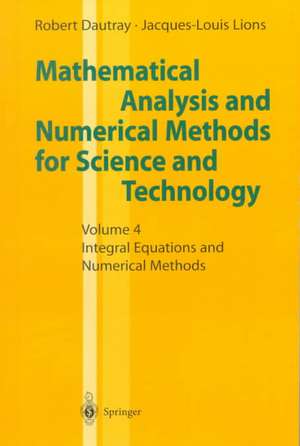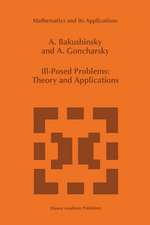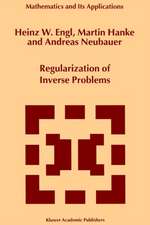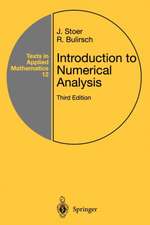Mathematical Analysis and Numerical Methods for Science and Technology: Volume 4 Integral Equations and Numerical Methods
Autor Robert Dautray Contribuţii de M. Artola Traducere de J.C. Amson Autor Jacques Louis Lions Contribuţii de P. Benilan, M. Bernadou, M. Cessenat, J.-C. Nedelec, J. Planchard, B. Scheureren Limba Engleză Paperback – 22 noi 1999
| Toate formatele și edițiile | Preț | Express |
|---|---|---|
| Paperback (6) | 471.93 lei 38-44 zile | |
| Springer Berlin, Heidelberg – 22 noi 1999 | 471.93 lei 38-44 zile | |
| Springer Berlin, Heidelberg – 22 noi 1999 | 471.96 lei 38-44 zile | |
| Springer Berlin, Heidelberg – 22 noi 1999 | 476.18 lei 38-44 zile | |
| Springer Berlin, Heidelberg – 22 noi 1999 | 480.70 lei 38-44 zile | |
| Springer Berlin, Heidelberg – 22 noi 1999 | 487.73 lei 38-44 zile | |
| Springer Berlin, Heidelberg – 22 noi 1999 | 494.15 lei 38-44 zile |
Preț: 471.96 lei
Preț vechi: 589.95 lei
-20% Nou
Puncte Express: 708
Preț estimativ în valută:
90.31€ • 94.72$ • 75.18£
90.31€ • 94.72$ • 75.18£
Carte tipărită la comandă
Livrare economică 28 martie-03 aprilie
Preluare comenzi: 021 569.72.76
Specificații
ISBN-13: 9783540661009
ISBN-10: 354066100X
Pagini: 504
Ilustrații: 1
Dimensiuni: 155 x 235 x 26 mm
Greutate: 0.7 kg
Ediția:2000
Editura: Springer Berlin, Heidelberg
Colecția Springer
Locul publicării:Berlin, Heidelberg, Germany
ISBN-10: 354066100X
Pagini: 504
Ilustrații: 1
Dimensiuni: 155 x 235 x 26 mm
Greutate: 0.7 kg
Ediția:2000
Editura: Springer Berlin, Heidelberg
Colecția Springer
Locul publicării:Berlin, Heidelberg, Germany
Public țintă
ResearchDescriere
The
advent
of
high-speed
computers
has
made
it
possible
for
the
first
time
to
calculate
values
from
models
accurately
and
rapidly.
Researchers
and
engineers
thus
have
a
crucial
means
of
using
numerical
results
to
modify
and
adapt
arguments
and
experiments
along
the
way.
Every
facet
of
technical
and
industrial
activity
has
been
affected
by
these
developments.
The
objective
of
the
present
work
is
to
compile
the
mathematical
knowledge
required
by
researchers
in
mechanics,
physics,
engineering,
chemistry
and
other
branches
of
application
of
mathematics
for
the
theoretical
and
numerical
resolution
of
physical
models
on
computers.
Since
the
publication
in
1924
of
the
"Methoden
der
mathematischen
Physik"
by
Courant
and
Hilbert,
there
has
been
no
other
comprehensive
and
up-to-date
publication
presenting
the
mathematical
tools
needed
in
applications
of
mathematics
in
directly
implementable
form.
Cuprins
X.
Mixed
Problems
and
the
Tricomi
Equation.-
§
1.
Description
and
Formulation
of
the
Problem.-
1.
Stationary
Plane
Flow
of
a
Compressible
Fluid.-
2.
Solution
in
the
Hodograph
Plane;
The
Frankl’
Equation.-
§
2.
Methods
for
Solving
Problems
of
Mixed
Type.-
1.
An
Example
of
a
Well-Posed
Boundary
Value
Problem
for
the
Frankl’
Equation.-
2.
Particular
Solutions.-
3.
Existence
and
Uniqueness
Results.-
Bibliographic
Commentary.-
XI.
Integral
Equations.-
A.
Solution
Methods
Using
Analytic
Functions
and
Sectionally
Analytic
Functions.-
§
1.
The
Wiener-Hopf
Method.-
Wiener-Hopf
Equations.-
1.
The
Wiener-Hopf
Method.-
2.
Decomposition
of
an
Analytic
Function
Defined
in
a
Strip
in
the
Complex
Plane.-
3.
Factorisation
of
an
Analytic
Function
Defined
in
a
Strip
in
the
Complex
Plane.-
4.
Application
to
the
Wiener-Hopf
Integral
Equation
of
the
Second
Kind.-
5.
Application
to
the
Milne
Problem.-
6.
Application
to
the
Dock
Problem.-
§
2.
Sectionally
Analytic
Functions.-
1.
S.
Analytic
Functions.-
2.
Cauchy
Integrals
and
Plemelj
Formulas.-
3.
The
Poincaré-Bertrand
Formula
and
the
Hilbert
Inversion
Formula.-
§
3.
The
Hilbert
Problem.-
1.
The
Hilbert
Problem
in
the
Case
where
L
is
a
Contour.-
2.
The
Hilbert
Problem
in
the
Case
where
L
is
an
Arc.-
3.
The
Hilbert
Problem
in
the
Case
of
a
Straight
Line.-
4.
Some
Problems
Reducible
to
a
Hilbert
Problem.-
§
4.
Application
to
Some
Problems
in
Physics.-
1.
Simple
Layer
and
Double
Layer
Problems.-
2.
Determination
of
the
Charge
Density
on
the
Surface
of
a
Cylindrical
Body
at
Potential
V.-
3.
The
Problem
of
the
Thin
Aerofoil
Profile.-
4.
Plane
Elasticity
and
the
Biharmonic
Equation.-
B.
Integral
Equations
Associated
with
Elliptic
Boundary
Value
Problems
in
Domains
in
?3.-
§
1.
Study
of
Certain
Weighted
Sobolev
Spaces.-
§
2.
Integral
Equations
Associated
with
the
Boundary
Value
Problems
of
Electrostatics.-
1.
Integral
Representations.-
2.
Dirichlet
Problems
Relative
to
the
Operator
?.-
3.
Neumann
Problems
Relative
to
the
Operator
?.-
§
3.
Integral
Equations
Associated
with
the
Helmholtz
Equation.-
§
4.
Integral
Equations
Associated
with
Problems
of
Linear
Elasticity.-
§
5.
Integral
Equations
Associated
with
the
Stokes
System.-
XII.
Numerical
Methods
for
Stationary
Problems.-
1.
The
Basic
Ideas
of
Finite
Difference
Methods
and
Finite
Element
Methods.-
2.
Comparison
of
the
Two
Methods.
Field
of
Applications
of
the
Finite
Element
Method.-
3.
The
Different
Topics
Treated
in
this
Chapter
XII.-
4.
The
Lax-Milgram
Theorem
and
Sobolev
Spaces.-
§
1.
Principal
Aspects
of
the
Finite
Element
Method
Applied
to
the
Problem
of
Linear
Elasticity.-
1.
Variational
Formulation
of
the
Continuous
Problem.-
2.
Construction
of
Approximation
Function
Spaces.-
3.
The
First
Approximation
Problem
(Ph1).-
4.
Numerical
Quadrature
Schemes
and
the
Definition
of
the
Second
Approximation
Problem
(Ph2).-
5.
Error
Estimates.-
6.
Numerical
Implementation.-
§
2.
Treatment
of
Domains
with
Curved
Boundaries.-
1.
“Exact”
Triangulation
of
the
Domain
?.-
2.
Construction
of
an
“Approximate”
Triangulation
of
the
Domain
?.-
3.
Examples
of
the
Construction
of
the
Mappings
FK.-
4.
Definition
of
Curved
Finite
Elements
of
Class
?0.-
5.
Estimation
of
the
Interpolation
Error.-
6.
Application
to
the
Solution
of
the
Problem
of
Plane
Linear
Elasticity.-
§
3.
A
Non
Conforming
Method
of
Finite
Elements.-
1.
The
Wilson
Finite
Element.-
2.
Estimation
of
the
Interpolation
Error.-
3.
The
Space
Xh
of
Finite
Elements.-
4.
The
Discrete
Problem.
Abstract
Error
Estimate.-
5.
The
Bilinear
Lemma.-
6.
Estimation
of
the
Error
$$
\parallel
\vec{u}
-
{\vec{u}_h}{\parallel_h}
$$.-
§
4.
Applications
to
the
Problems
of
Plates
and
Shells.-
1.
Approximation
of
the
Problems
of
Plates.-
2.
Approximation
of
the
Problems
of
Shells.-
§
5
Approximation
of
Eigenvalues
and
Eigenvectors.-
1.
Some
Results
from
the
Spectral
Theory
of
Differential
Operators.-
2.
The
Approximate
Problem.-
3.
Estimation
of
the
Errors
$$
\left|
{{{\vec{\lambda
}}_j}
-
{{\vec{\lambda
}}_{{hj}}}}
\right|,1
\leqslant
j
\leqslant
3{M_h}
$$.-
4.
Estimation
of
the
Errors
$$
\parallel
{\vec{u}_j}
-
{\vec{u}_{{hj}}}\parallel,
1
\leqslant
j
\leqslant
3{M_h}
$$.-
5.
Numerical
Solutions.-
§
6.
An
Example
of
the
Approximate
Calculation
for
a
Problem
of
the
Eigenvalues
of
a
Non
Self-Adjoint
Operator.-
1.
The
Neutron
Diffusion
Equations
Recalled.-
2.
The
Critical
Problem
with
Two
Energy
Groups.-
3.
Determination
of
the
Positive
Solution.-
4.
Extension
to
the
Case
Where
the
Number
of
Neutron
(Kinetic)
Energy
Groups
is
Greater
than
Two.-
5.
The
Eigenvalue
Problem
Connected
with
the
Evolution
Problem
of
Neutron
Diffusion.-
6.
Some
Comments.-
Review
of
Chapter
XII.-
XIII.
Approximation
of
Integral
Equations
by
Finite
Elements.
Error
Analysis.-
§
1.
The
Case
of
a
Polyhedral
Surface.-
1.
The
Simple
Layer
Potential
Case
for
the
Dirichlet
Problem.-
2.
Study
of
the
Potential
of
a
Double
Layer
for
the
Neumann
Problem
in
?3.-
3.
Study
of
the
Exterior
Neumann
Problem
Represented
by
a
Simple
Layer.-
§
2.
The
Case
of
a
Regular
Closed
Surface.-
1.
The
Approximation
of
Surfaces.-
2.
Notions
on
the
Error
Generated
by
the
Approximation
of
the
Surface.-
Appendix.
“Singular
Integrals”.-
§
1.
Operator,
Convolution
Operator,
Integral
Operator.-
§
2.
The
Hilbert
Transformation.-
§
3.
Generalities
on
Singular
Integral
Operators.-
§
5.
The
Calderon-Zygmund
Theorem.-
§
6.
Marcinkiewicz
Spaces.-
1.
Definitions.-
2.
Application
to
the
Homogeneous
Convolution
Kernel.-
4.
Operators
of
Weak
Type.
The
Marcinkiewicz
Theorem.-
5.
The
Maximal
Hardy-Littlewood
Operator..-
Proof
of
Lemma
1
in
§
2.-
Table
of
Notations.-
of
Volumes1–3,
5,
6.



















